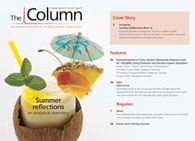Pest detection
New indicators of plant health have been identified by gas chromatography that could provide a remote method for identifying plants that are under attack from pests.

New indicators of plant health have been identified by gas chromatography that could provide a remote method for identifying plants that are under attack from pests.
The monitoring of insect populations is an important part of pest management and is usually performed by human scouts spotting and counting the insects on individual plants within a greenhouse. However a recent study into the herbivore-induced plant volatiles (HIPVs) published in Pest Management Science sought to investigate whether the HIPVs had the potential for use in advanced insect monitoring technologies.1
Tomato plants were infested with caterpillars and then had volatiles collected from the vicinity of these plants. The profiles of these volatiles were determined by GC–MS and allowed the researchers to identify three compounds that act as specific indicators of herbivory. Using an ultrafast portable gas chromatograph in a research greenhouse and in a commercial greenhouse the study found it was possible to differentiate between the emissions of plants to determine which were under attack within six hours of infestation. The study concluded that monitoring plant volatiles has potential as a pest monitoring technique, but more research is required to fully understand the concept.
S. Miresmailli et al., Pest Management Science, 66(8), 916–924 (2010).
This story originally appeared in The Column. Click here to view that issue.
Characterizing Polyamides Using Reversed-Phase Liquid Chromatography
May 5th 2025Polyamides can be difficult to characterize, despite their use in various aspects of everyday life. Vrije Universiteit Amsterdam researchers hoped to address this using a reversed-phase liquid chromatography (RPLC)-based approach.
Navigating The Path To Modern Slalom Chromatography: An Interview with Fabrice Gritti
May 1st 2025Fabrice Gritti, consultant scientist at Waters Corporation, spoke to LCGC International about the history of slalom chromatography (SC) and why he decided that the technique was worth re-investigating. The potential benefits of SC, according to Gritti, include identifying RNA impurities when manufacturing mRNA therapeutics, and assisting in the development of new gene and cell therapies, and other biopharmaceutical applications.

.png&w=3840&q=75)

.png&w=3840&q=75)



.png&w=3840&q=75)



.png&w=3840&q=75)









